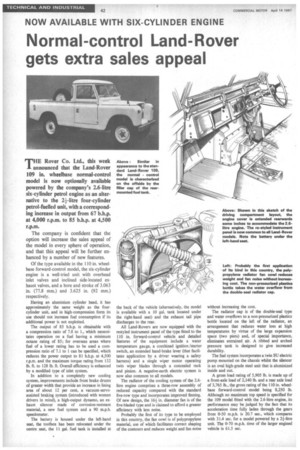Normal-control Land-Rover gets extra sales appeal
Page 44

If you've noticed an error in this article please click here to report it so we can fix it.
THE Rover Co. Ltd., this week announced that the Land-Rover 109 in. wheelbase normal-control model is now optionally available powered by the company's 2.6-litre six-cylinder petrol engine as an alternative to the 2f-litre four-cylinder petrol-fuelled unit, with a corresponding increase in output from 67 b.h.p. at 4,000 r.p.m. to 85 b.h.p. at 4,500 r.p.m.
The company is confident that the option will increase the sales appeal of the model in every sphere of operation, and that this appeal will be further enhanced by a number of new features.
Of the type available in the 110 in. wheelbase forward-control model, the six-cylinder engine is a well-tried unit with overhead inlet valves and inclined side-located exhaust valves, and a bore and stroke of 3.063 in. (77.8 mm.) and 3.625 in. (92 mm.) respectively.
Having an aluminium cylinder head, it has approximately the same weight as the fourcylinder unit, and in high-compression form its use should not increase fuel consumption if its additional power is not exploited.
The output of 85 b.h.p. is obtainable with a compression ratio of 7.8 to 1., which necessitates operation on a fuel having a minimum octane rating of 85; for overseas areas where fuel of a lower rating has to be used a compression ratio of 7.1 to 1 can be specified, which reduces the power output to 81 b.h.p. at 4,500 r.p.m. and the maximum torque rating from 132 lb. ft. to 128 lb. ft. Overall efficiency is enhanced by a modified type of inlet system.
In addition to a completely new cooling system, improvements include front brake drums of greater width that provide an increase in lining area of about 12 per cent, a vacuum-servoassisted braking system (introduced with women drivers in mind), a high-output dynamo, an exhaust silencer made of corrosion-resistant material, a new fuel system and a 90 m.p.h. speedometer.
The battery is housed under the left-hand seat, the toolbox has been relocated under the centre seat, the 11 gal. fuel tank is installed at
the back of the vehicle (alternatively, the model is available with a 10 gal. tank located under the right-hand seat) and the exhaust tail pipe discharges to the rear.
All Land-Rovers are now equipped with the restyled instrument panel of the type fitted to the 110 in. forward-control vehicle and detailed features of the equipment include a water temperature gauge, a combined ignition /starter switch, an extended hand-brake lever (that facilitates application by a driver wearing a safety harness) and a single wiper motor operating twin wiper blades through a concealed rack and pinion. A negative-earth electric system is now also common to all models.
The radiator of the cooling system of the 2.6litre engine comprises a three-row assembly of reduced capacity compared with the standard five-row type and incorporates improved finning. Of new design, the 164 in. diameter fan is of the five-bladed type and is claimed to afford a greater efficiency with less noise.
Probably the first of its type to be employed in this country, the fan cowl is of polypropylene material, use of which facilitates correct shaping of the contours and reduces weight and fan noise
without increasing the cost.
The radiator cap is of the double-seal type and water overflows to a non-pressurized plastics bottle located on the left of the radiator, an arrangement that reduces water loss at high temperatures by virtue of the large expansion space (two pints) and, of special importance, eliminates entrained air. A ribbed and arched pressure tank is designed to give increased durability.
The fuel system incorporates a twin SU electric pump mounted on the chassis whilst the silencer is an oval high-grade steel unit that is aluminized inside and out.
A gross load rating of 5,905 lb. is made up of a front-axle load of 2,140 lb. and a rear axle load of 3,765 lb., the gross rating of the 110 in. wheelbase forward-control model being 8,250 lb. Although no maximum top speed is specified for the 109 model fitted with the 2.6-litre engine, its performance may be judged by the fact that its acceleration time fully laden through the gears from 0-50 m.p.h. is 20.7 sec., which compares with 31.4 sec. for a model powered by a 2+-litre unit. The 0-70 m.p.h. time of the larger engined vehicle is 61.5 sec.
























































































































